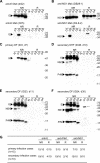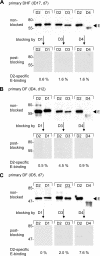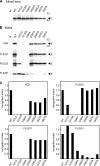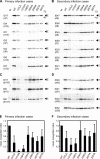Antibodies to envelope glycoprotein of dengue virus during the natural course of infection are predominantly cross-reactive and recognize epitopes containing highly conserved residues at the fusion loop of domain II
- PMID: 18448542
- PMCID: PMC2447043
- DOI: 10.1128/JVI.00316-08
Antibodies to envelope glycoprotein of dengue virus during the natural course of infection are predominantly cross-reactive and recognize epitopes containing highly conserved residues at the fusion loop of domain II
Abstract
The antibody response to the envelope (E) glycoprotein of dengue virus (DENV) is known to play a critical role in both protection from and enhancement of disease, especially after primary infection. However, the relative amounts of homologous and heterologous anti-E antibodies and their epitopes remain unclear. In this study, we examined the antibody responses to E protein as well as to precursor membrane (PrM), capsid, and nonstructural protein 1 (NS1) of four serotypes of DENV by Western blot analysis of DENV serotype 2-infected patients with different disease severity and immune status during an outbreak in southern Taiwan in 2002. Based on the early-convalescent-phase sera tested, the rates of antibody responses to PrM and NS1 proteins were significantly higher in patients with secondary infection than in those with primary infection. A blocking experiment and neutralization assay showed that more than 90% of anti-E antibodies after primary infection were cross-reactive and nonneutralizing against heterologous serotypes and that only a minor proportion were type specific, which may account for the type-specific neutralization activity. Moreover, the E-binding activity in sera of 10 patients with primary infection was greatly reduced by amino acid replacements of three fusion loop residues, tryptophan at position 101, leucine at position 107, and phenylalanine at position 108, but not by replacements of those outside the fusion loop of domain II, suggesting that the predominantly cross-reactive anti-E antibodies recognized epitopes involving the highly conserved residues at the fusion loop of domain II. These findings have implications for our understanding of the pathogenesis of dengue and for the future design of subunit vaccine against DENV as well.
Figures






Similar articles
-
Engineered Dengue Virus Domain III Proteins Elicit Cross-Neutralizing Antibody Responses in Mice.J Virol. 2018 Aug 29;92(18):e01023-18. doi: 10.1128/JVI.01023-18. Print 2018 Sep 15. J Virol. 2018. PMID: 29976679 Free PMC article.
-
The potent and broadly neutralizing human dengue virus-specific monoclonal antibody 1C19 reveals a unique cross-reactive epitope on the bc loop of domain II of the envelope protein.mBio. 2013 Nov 19;4(6):e00873-13. doi: 10.1128/mBio.00873-13. mBio. 2013. PMID: 24255124 Free PMC article.
-
High-avidity and potently neutralizing cross-reactive human monoclonal antibodies derived from secondary dengue virus infection.J Virol. 2013 Dec;87(23):12562-75. doi: 10.1128/JVI.00871-13. Epub 2013 Sep 11. J Virol. 2013. PMID: 24027331 Free PMC article.
-
Isolation of dengue virus-specific memory B cells with live virus antigen from human subjects following natural infection reveals the presence of diverse novel functional groups of antibody clones.J Virol. 2014 Nov;88(21):12233-41. doi: 10.1128/JVI.00247-14. Epub 2014 Aug 6. J Virol. 2014. PMID: 25100837 Free PMC article.
-
The human immune response to Dengue virus is dominated by highly cross-reactive antibodies endowed with neutralizing and enhancing activity.Cell Host Microbe. 2010 Sep 16;8(3):271-83. doi: 10.1016/j.chom.2010.08.007. Cell Host Microbe. 2010. PMID: 20833378 Free PMC article.
Cited by
-
An adjuvanted, tetravalent dengue virus purified inactivated vaccine candidate induces long-lasting and protective antibody responses against dengue challenge in rhesus macaques.Am J Trop Med Hyg. 2015 Apr;92(4):698-708. doi: 10.4269/ajtmh.14-0268. Epub 2015 Feb 2. Am J Trop Med Hyg. 2015. PMID: 25646261 Free PMC article.
-
CD8+ T Cells Can Mediate Short-Term Protection against Heterotypic Dengue Virus Reinfection in Mice.J Virol. 2015 Jun;89(12):6494-505. doi: 10.1128/JVI.00036-15. Epub 2015 Apr 8. J Virol. 2015. PMID: 25855749 Free PMC article.
-
Sequential immunization induces strong and broad immunity against all four dengue virus serotypes.NPJ Vaccines. 2020 Jul 24;5(1):68. doi: 10.1038/s41541-020-00216-0. eCollection 2020. NPJ Vaccines. 2020. PMID: 32728482 Free PMC article.
-
Basics of memory B-cell responses: lessons from and for the real world.Immunology. 2019 Feb;156(2):120-129. doi: 10.1111/imm.13019. Epub 2018 Nov 29. Immunology. 2019. PMID: 30488482 Free PMC article. Review.
-
T Cell Responses to Nonstructural Protein 3 Distinguish Infections by Dengue and Zika Viruses.mBio. 2018 Aug 7;9(4):e00755-18. doi: 10.1128/mBio.00755-18. mBio. 2018. PMID: 30087165 Free PMC article.
References
-
- Alvarez, M., R. Rodriguez-Roche, L. Bernardo, S. Vazquez, L. Morier, D. Gonzalez, O. Castro, G. Kouri, S. B. Halstead, and M. G. Guzman. 2006. Dengue hemorrhagic Fever caused by sequential dengue 1-3 virus infections over a long time interval: Havana epidemic, 2001-2002. Am. J. Trop. Med. Hyg. 751113-1117. - PubMed
-
- Bray, M., and C. J. Lai. 1991. Dengue virus premembrane and membrane proteins elicit a protective immune response. Virology 185505-508. - PubMed
-
- Burke, D. S., A. Nisalak, D. E. Johnson, and R. M. Scott. 1988. A prospective study of dengue infections in Bangkok. Am. J. Trop. Med. Hyg. 38172-180. - PubMed
-
- Churdboonchart, V., N. Bhamarapravati, S. Peampramprecha, and S. Sirinavin. 1991. Antibodies against dengue viral proteins in primary and secondary dengue hemorrhagic fever. Am. J. Trop. Med. Hyg. 44481-493. - PubMed
Publication types
MeSH terms
Substances
LinkOut - more resources
Full Text Sources
Other Literature Sources
Research Materials

